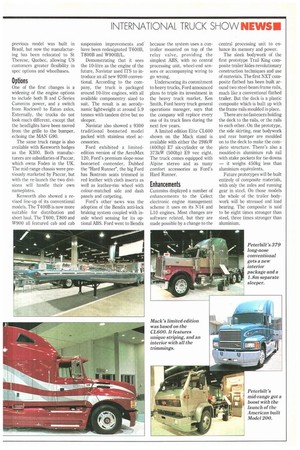Stateside builders strutting their stuff
Page 8

Page 9

If you've noticed an error in this article please click here to report it so we can fix it.
• Reflecting the confidence in a slowly recovering American economy, the International Truck Show at Anaheim, California on America's West Coast featured four new heavy Class 8 trucks and three new mid-range Class 6 and 7, chassis.
To mark its 50th anniversary as a truck manufacturer, Freightliner chose ITS to launch a premium conventional (bonneted) model with an integral 1.8m sleeper. Freightliner's new flagship is intended for the successful owner-operator and the small, high-profile fleet that wants to tempt drivers with the best equipment.
Peterbilt launched its latest in cab comfort, a 1.8m walk-in sleeper on its bonneted 379. It also features Peterbilt's latest noise suppression interior, which is claimed to render the cab among the quietest in the industry.
But bigger news was the revamped and re-launched midrange Peterbilt. This is now designated the model 200, and features the Volkswagen/MAN LT cab with a North American frame and running gear. The previous model was built in Brazil, but now the manufacturing has been relocated to St Therese, Quebec, allowing US customers greater flexibility in spec options and wheelbases.
Options
One of the first changes is a widening of the engine options to include both B and C-Series Cummins power, and a switch from Rockwell to Eaton axles. Externally, the trucks do not look much different, except that the headlights have been moved from the grille to the bumper, echoing the MAN G90.
The same truck range is also available with Kenworth badges as the K300. Both manufacturers are subsidiaries of Paccar, which owns Foden in the UK. The mid-range chassis were previously marketed by Paccar, but with the re-launch the two divisions will handle their own nameplates.
Kenworth also showed a revised line-up of its conventional models. The T400B is now more suitable for distribution and short haul. The T600, T800 and W900 all featured cab and cab suspension improvements and have been redesignated T600B, T800B and W90013/L.
Demonstrating that it sees the 10-litre as the engine of the future, Navistar used ITS to introduce an all new 9200 conventional. According to the company, the truck is packaged around 10-litre engines, with all available componentry sized to suit. The result is an aerodynamic lightweight at around 5.9 tonnes with tandem drive but no sleeper.
Navistar also showed a 9300 traditional bonneted model packed with stainless steel accessories, Ford exhibited a limitededition version of the AeroMax 120, Ford's premium slope-nose bonneted contender. Dubbed the "Hard Runner", the big Ford has Bostrorn seats trimmed in red leather with cloth inserts as well as leather-rim wheel with colour-matched side and dash panels and carpeting.
Ford's other news was the adoption of the Bendix anti-lock braking system coupled with inaxle wheel sensing for its optional ABS. Ford went to Bendix because the system uses a controller mounted on top of the relay valve, providing the simplest ABS, with no central processing unit, wheel-end sensors or accompanying wiring to go wrong.
Underscoring its commitment to heavy trucks, Ford announced plans to triple its investment in the heavy truck market. Ken Smith, Ford heavy truck general operations manager, says that the company will replace every one of its truck lines during the next few years.
A limited edition Elite CL600 shown on the Mack stand is available with either the 298kW (400hp) E7 six-cylinder or the 373kW (500hp) E9 vee eight. The truck comes equipped with Alpine stereo and as many comfort accessories as Ford's Hard Runner.
Enhancements
Cummins displayed a number of enhancements to the Celect electronic engine management scheme it uses on its N14 and L10 engines. Most changes are software related, but they are made possible by a change to the central processing unit to enhance its memory and power.
The sleek bodywork of the first prototype Trail King composite trailer hides revolutionary construction techniques and use of materials. The first NXT composite flatbed has been built around two steel-beam frame rails, much like a conventional flatbed trailer. But the deck is a plastic composite which is built up with the frame rails moulded in place.
There are no fasteners holding the deck to the rails, or the rails to each other. On the prototype, the side skirting, rear bodywork and rear bumper are moulded on to the deck to make the complete structure. There's also a moulded-in aluminium rub rail with stake pockets for tie-downs — it weighs 450kg less than aluminium equivalents.
Future prototypes will be built entirely of composite materials, with only the axles and running gear in steel. On those models the whole of the trailer bodywork will be stressed and load bearing. The composite is said to be eight times stronger than steel, three times stronger than aluminium.












































































